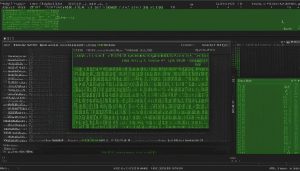Logical Volume Manager (LVM) is a powerful storage virtualization solution that offers system administrators a more flexible approach to managing disk storage space compared to traditional partitioning. With LVM, storage is managed by chunking physical volumes (PVs) into physical extents (PEs) and mapping them onto logical extents (LEs), which are then pooled into volume groups (VGs). These volume groups are further linked together into logical volumes (LVs), acting as virtual disk partitions.
LVM allows for on-demand allocation of storage space, making it easy to add new storage without redistributing user files. It simplifies the resizing and movement of storage volumes, providing benefits such as data segmentation and the combination of partitions. In an enterprise environment, LVM serves as a powerful tool for managing storage needs efficiently.
Key Takeaways:
- LVM is a storage virtualization solution that offers flexible disk space management.
- It allows for on-demand allocation of storage space and simplifies resizing and movement of storage volumes.
- LVM enables the combination of partitions and the addition of new storage without redistributing user files.
- In an enterprise environment, LVM is a valuable tool for managing storage needs efficiently.
- With LVM, sysadmins have greater control and flexibility over their storage infrastructure.
The Basics of LVM
The Logical Volume Manager (LVM) offers several benefits over traditional storage partitioning methods. With LVM, administrators have the flexibility to allocate storage space on an as-needed basis, rather than having to allocate all disk storage space during initial setup. This allows for better resource utilization and prevents wastage of storage capacity. Additionally, LVM allows for the segmentation of logically sequential data and the combination of partitions, which can improve data throughput and simplify the resizing and movement of storage volumes.
One of the key advantages of LVM is the ability to add new storage to a specific volume group without redistributing user files. This makes it easier to manage storage for different user groups within an enterprise environment. LVM also provides a seamless transition when migrating data from old drives to new drives, minimizing any disruptions to end users. When compared to traditional partitioning methods, LVM offers a greater level of flexibility and efficiency in managing storage resources.
To summarize, the benefits of LVM over traditional partitioning include:
- Allocation of storage space on demand
- Segmentation of data and combination of partitions
- Smooth transition of data to new drives
- Flexibility in managing storage for different user groups
- Improved efficiency and resource utilization
| LVM Benefits | LVM vs Traditional Partitioning |
|---|---|
| Flexible allocation of storage space | Storage space allocated during initial setup |
| Segmentation of data and combination of partitions | Separate partitions for different storage needs |
| Smooth transition of data to new drives | Data migration requires complex tasks |
| Efficient management of storage for different user groups | Redistribution of user files required |
| Improved efficiency and resource utilization | Less flexible and efficient use of storage resources |
In conclusion, LVM provides a more flexible and efficient approach to managing disk storage space compared to traditional partitioning methods. Its benefits include the ability to allocate storage space on demand, segment data, combine partitions, and easily manage storage for different user groups. With LVM, administrators can optimize resource utilization and seamlessly transition data to new drives, all while simplifying the resizing and movement of storage volumes.
LVM Structure
Logical Volume Manager (LVM) follows a hierarchical structure that consists of physical volumes (PVs), volume groups (VGs), and logical volumes (LVs). This structure enables flexible and efficient management of disk storage space in an enterprise environment.
Physical Volumes (PVs)
Physical volumes are the building blocks of LVM. They can be physical disks or partitions that are initialized for use with LVM. PVs store the actual data and metadata of the logical volumes. Multiple PVs can be combined to increase the storage capacity and performance of the system.
Volume Groups (VGs)
Volume groups are created by combining one or more PVs. They act as storage pools that contain the combined capacity of the PVs. VGs provide the ability to allocate and manage storage resources at a higher level than individual PVs. It allows for the easy addition of disk space and provides a centralized storage management interface.
Logical Volumes (LVs)
Logical volumes are carved out of the volume groups and serve as virtual disk partitions. They represent the usable storage space that can be allocated to various purposes, such as filesystems or databases. LVs are flexible and can be resized, moved, or extended as needed without disrupting the underlying data. LVM enables sysadmins to allocate storage space according to the specific requirements of different applications or user groups.
Overall, LVM’s structure provides the ability to pool physical storage resources, allocate storage space on-demand, and easily resize or move logical volumes without downtime. This flexibility and efficiency make LVM a valuable tool for managing storage needs in enterprise environments.
| LVM Feature | Advantages |
|---|---|
| Flexible Disk Space Management | Allows sysadmins to allocate storage space on-demand, accommodating changing storage needs. |
| Dynamic Allocation and Resizing | Enables the easy addition, removal, and resizing of storage volumes without disrupting data or services. |
| Centralized Storage Management | Provides a unified interface to manage storage resources across multiple physical volumes. |
| Combining Multiple Physical Disks | Allows the pooling of storage capacity from different physical disks into a single volume group for efficient storage utilization. |
| Redundancy and Data Protection | Supports features like mirroring and striping to enhance data protection and availability. |
Expanding a Filesystem on the Fly with LVM
One of the key use cases of Logical Volume Manager (LVM) is the ability to expand a filesystem on the fly without the need for reformatting or restarting the system. This feature is particularly useful in scenarios where storage needs to be increased without disrupting critical programs or services. LVM provides a set of commands that facilitate the implementation and management of storage resources, allowing sysadmins to easily add disk space, extend existing storage, and resize filesystems.
The implementation of LVM involves installing new hard drives, creating partitions or utilizing existing ones, initializing them as physical volumes (PVs), and combining them into volume groups (VGs). Once the VGs are created, logical volumes (LVs) can be carved out of them, acting as virtual disk partitions. To expand a filesystem on the fly, sysadmins can use LVM commands such as pvcreate to initialize the physical volumes, vgextend to add the new PVs to the volume groups, and lvextend to increase the size of the logical volumes. These commands allow for seamless expansion of the filesystem while it is mounted and active.
Expand storage capacity on the fly with LVM, without the need for reformatting or system restart. With commands like pvcreate, vgextend, and lvextend, sysadmins can easily add new disk space, extend existing storage, and resize filesystems, ensuring minimal disruption to critical programs and services.
By leveraging LVM’s capabilities, sysadmins can efficiently manage storage resources, adapt to evolving storage needs, and optimize resource utilization within an enterprise environment. The ability to expand a filesystem on the fly provides flexibility and scalability, enabling organizations to dynamically adjust storage capacity as required.
| LVM Commands | Function |
|---|---|
| pvcreate | Initialize a physical volume for use with LVM |
| vgextend | Add physical volumes to a volume group |
| lvextend | Extend the size of a logical volume |
LVM vs Traditional Partitioning
When it comes to managing storage capacity, Logical Volume Manager (LVM) offers significant advantages over traditional partitioning. LVM takes a more flexible and efficient approach by combining the storage capacity of multiple drives into volume groups (VGs). This allows sysadmins to manage storage space as a whole, rather than dealing with individual drives. On the other hand, traditional partitioning treats each drive separately, limiting the ability to efficiently allocate and manage storage.
With LVM, sysadmins can easily expand a file system on the fly without the need for reformatting or restarting the system. This is particularly useful when storage needs to be increased without disrupting critical programs or services. In contrast, traditional partitioning requires taking the system offline and performing complex tasks such as installing new hard drives and moving data between partitions. LVM simplifies the process by providing a set of commands that facilitate the management of storage resources.
One of the key benefits of LVM is its ability to scale storage capacity easily and quickly. Sysadmins can add new disks or partitions, designate them as physical volumes (PVs), and add them to existing volume groups (VGs). This increased capacity can then be allocated to existing logical volumes (LVs), extending their size. In contrast, traditional partitioning requires manual intervention, such as repartitioning or replacing drives, which can be time-consuming and disruptive.
LVM vs Traditional Partitioning: A Comparison
| LVM | Traditional Partitioning |
|---|---|
| Combines storage capacity of multiple drives into volume groups | Treats each drive separately |
| Allows for easy expansion of file systems on the fly | Requires system downtime for partitioning and data migration |
| Provides commands for efficient management of storage resources | Manual intervention required for resizing or replacing drives |
| Enables easy scalability by adding new disks or partitions | Scaling requires repartitioning or replacing drives |
By leveraging LVM, sysadmins can achieve greater flexibility, efficiency, and control over their storage infrastructure. With its ability to combine storage capacity, expand file systems on the fly, and scale easily, LVM offers a superior solution compared to traditional partitioning when it comes to managing storage capacity in an enterprise environment.
Scaling Capacity with LVM
Logical Volume Manager (LVM) offers significant benefits when it comes to scaling storage capacity. With LVM, sysadmins have the ability to easily and quickly increase storage capacity by adding new disks or partitions and incorporating them into existing volume groups (VGs). This scalable approach allows for efficient allocation of storage resources as the needs of the enterprise evolve. Whether it involves expanding storage to accommodate growing data or optimizing resource utilization, LVM provides a seamless solution.
By adding new disks or partitions and designating them as physical volumes (PVs), sysadmins can increase the storage capacity of their environment. These PVs can then be added to existing volume groups (VGs), effectively pooling the additional storage space. The increased capacity can then be allocated to existing logical volumes (LVs), extending their size to meet the growing demands of the enterprise.
With LVM’s flexibility in scaling storage capacity, sysadmins can adapt their infrastructure to changing storage requirements without disruption. Whether it’s expanding storage to support new applications or reducing capacity to optimize resource utilization, LVM provides sysadmins with the tools they need to efficiently manage their storage environment. With its ability to easily add or remove disks and partitions, LVM offers a versatile and scalable solution for organizations of all sizes.
Key Advantages of Scaling Capacity with LVM:
- Easy and quick addition of new disks or partitions
- Efficient allocation of storage resources
- Seamless adaptation to changing storage requirements
- Versatile and scalable solution for organizations of all sizes
Table: Comparison of Traditional Storage Management and LVM
| Traditional Storage Management | LVM |
|---|---|
| Individual hard drives considered separately | Pooling of storage capacity from multiple drives |
| Storage capacity based on maximum capacity of each drive | Flexible allocation of storage space on demand |
| Complex tasks like installing new hard drives and moving data between partitions for capacity expansion | Easy addition of disks or partitions to increase capacity |
| System downtime required for capacity expansion | Capacity expansion while the system remains online |
Reducing Capacity with LVM
Logical Volume Manager (LVM) not only offers the flexibility to expand storage capacity but also provides the capability to reduce capacity if necessary. When it comes to reducing capacity with LVM, the process involves removing physical volumes (PVs) from volume groups (VGs) and reclaiming the freed space. However, it’s important to note that the XFS filesystem does not support direct shrinking, so data backup and restoration are required.
In contrast, the ext4 filesystem can be resized on the fly, enabling the reduction of storage space without the need for reformatting or restarting the system. This makes it possible to reduce storage capacity without disrupting critical programs or services. To facilitate the reduction of capacity, LVM provides a set of commands that sysadmins can use.
For instance, the pvremove command can be used to remove physical volumes from volume groups. By specifying the PVs that need to be removed, sysadmins can effectively reclaim the storage space allocated to those volumes. Similarly, the vgreduce command can be utilized to remove physical volumes from volume groups, freeing up the associated space.
Lastly, the lvreduce command allows sysadmins to reduce the size of logical volumes, thus further optimizing storage capacity. By specifying the LVs and the desired reduction in size, sysadmins can easily adjust the allocated space to match the requirements of their storage infrastructure. Overall, LVM provides sysadmins with the flexibility to adjust storage capacity as needed, whether it involves increasing or reducing capacity.
| LVM Commands | Description |
|---|---|
| pvremove | Removes physical volumes (PVs) from volume groups (VGs), reclaiming the associated space. |
| vgreduce | Removes physical volumes (PVs) from volume groups (VGs), freeing up the allocated storage space. |
| lvreduce | Reduces the size of logical volumes (LVs), optimizing storage capacity. |
By leveraging these LVM commands, sysadmins can effectively manage storage capacity, whether it involves increasing or reducing capacity. These commands provide a seamless and efficient solution for adjusting storage resources, allowing for greater control over storage infrastructure.
Conclusion
In summary, the Logical Volume Manager (LVM) is an essential tool for effectively managing disk storage space in an enterprise environment. Its numerous benefits make it a preferred choice over traditional partitioning methods. With LVM, sysadmins can allocate storage space on demand, simplify resizing and moving of storage volumes, and combine multiple physical disks into a single volume group.
The implementation and management of storage resources with LVM are made straightforward through a set of commands that sysadmins can leverage. Whether it’s expanding storage capacity on the fly, scaling up or down, or optimizing resource utilization, LVM provides the necessary tools for efficient storage management.
In conclusion, the LVM tutorial has highlighted the versatility and efficiency of LVM in meeting the evolving storage needs of enterprises. By utilizing LVM, sysadmins can gain greater flexibility, efficiency, and control over their storage infrastructure, ultimately enhancing the overall performance and reliability of their systems.
FAQ
What is Logical Volume Manager (LVM)?
LVM is a form of storage virtualization that offers system administrators a more flexible approach to managing disk storage space than traditional partitioning.
How does LVM work?
LVM works by chunking physical volumes (PVs) into physical extents (PEs) and mapping them onto logical extents (LEs) which are then pooled into volume groups (VGs). These groups are linked together into logical volumes (LVs) that act as virtual disk partitions.
What are the benefits of using LVM?
LVM provides benefits such as segmentation of data, combining of partitions, and the ability to add new storage without redistributing user files. It also simplifies the resizing and movement of storage volumes.
How does LVM differ from traditional partitioning?
LVM allows for the allocation of storage space on an as-needed basis, while traditional partitioning requires allocating all disk storage space at initial setup. LVM also provides more flexibility and efficiency in managing storage resources.
What is the structure of an LVM environment?
The structure of an LVM environment consists of physical volumes (PVs), volume groups (VGs), and logical volumes (LVs). PVs are initialized disks or partitions, VGs are created by combining PVs, and LVs act as virtual disk partitions carved out of VGs.
Can the filesystem be expanded on the fly with LVM?
Yes, LVM allows for the addition of disk space to a logical volume and its filesystem while the filesystem is mounted and active, without the need for reformatting or restarting the system.
How does LVM compare to traditional storage management?
LVM combines or pools the storage capacity of multiple drives into volume groups, allowing for more efficient management of storage space compared to traditional partitioning which treats each drive separately.
How can storage capacity be scaled with LVM?
LVM allows for the easy addition of disk space by creating new physical volumes (PVs), extending existing volume groups (VGs), and adding new logical volumes (LVs).
Is it possible to reduce storage capacity with LVM?
Yes, LVM provides the capability to shrink storage capacity by removing physical volumes (PVs) from volume groups (VGs) and reclaiming the freed space.
Hi, I’m Mark, the author of Clever IT Solutions: Mastering Technology for Success. I am passionate about empowering individuals to navigate the ever-changing world of information technology. With years of experience in the industry, I have honed my skills and knowledge to share with you. At Clever IT Solutions, we are dedicated to teaching you how to tackle any IT challenge, helping you stay ahead in today’s digital world. From troubleshooting common issues to mastering complex technologies, I am here to guide you every step of the way. Join me on this journey as we unlock the secrets to IT success.


